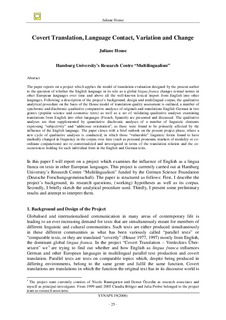Covert Translation, Language Contact, Variation and Change
Journal article
Permanent lenke
http://hdl.handle.net/11250/2401110Utgivelsesdato
2006Metadata
Vis full innførselSamlinger
Originalversjon
SYNAPS - A Journal of Professional Communication 19(2006) pp.25-47Sammendrag
The paper reports on a project which applies the model of translation evaluation designed by the present author
to the question of whether the English language in its role as a global lingua franca changes textual norms in
other European languages over time and above all the well-known lexical import from English into other
languages. Following a description of the project’s background, design and multilingual corpus, the qualitative
analytical procedure on the basis of the House model of translation quality assessment is outlined, a number of
synchronic and diachronic qualitative comparative analyses of originals and translations English-German in two
genres (popular science and economic texts) as well as a set of validating qualitative analyses examining
translations from English into other languages (French, Spanish) are presented and discussed. The qualitative
analyses are then supplemented by quantitative diachronic analyses of a number of linguistic elements
expressing “subjectivity” and “addressee orientation”, as these were found to be primarily affected by the
influence of the English language. The paper closes with a brief outlook on the present project phase, where a
new cycle of qualitative analyses is conducted, in which those “vulnerable” linguistic forms found to have
markedly changed in frequency in the corpus over time (such as personal pronouns, markers of modality or coordinate
conjunctions) are re-contextualized and investigated in terms of the translation relation and the co-occurrences
holding for each individual form in the English and German texts.
